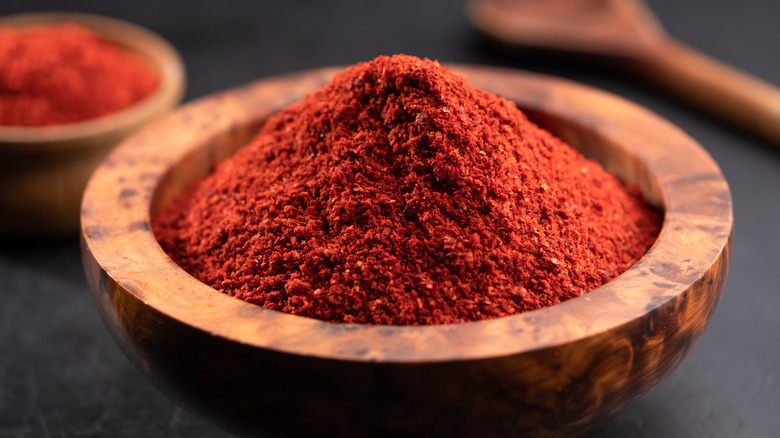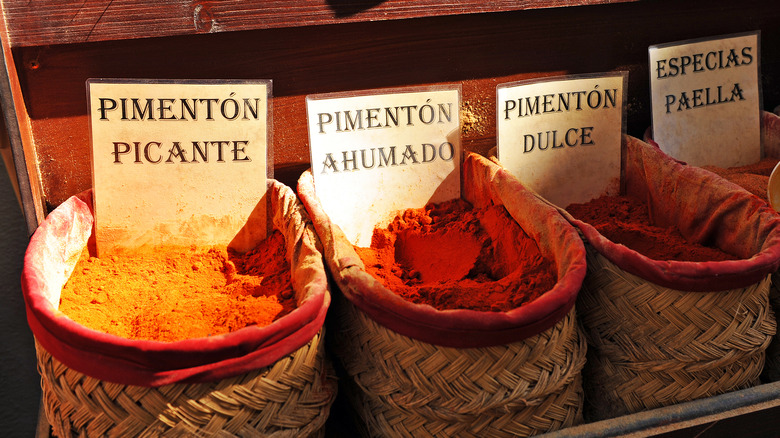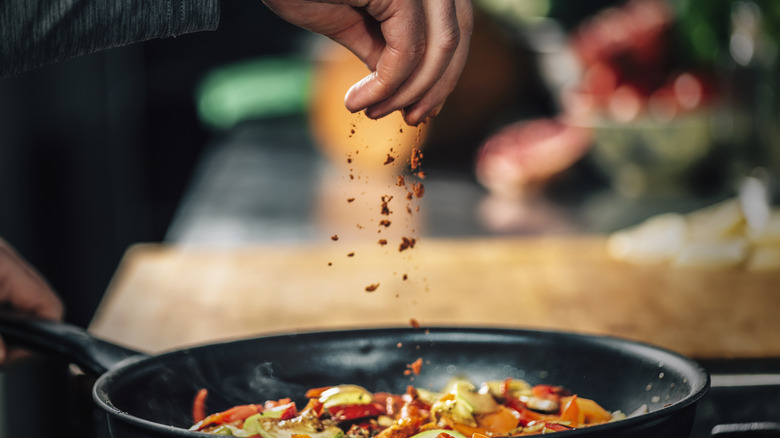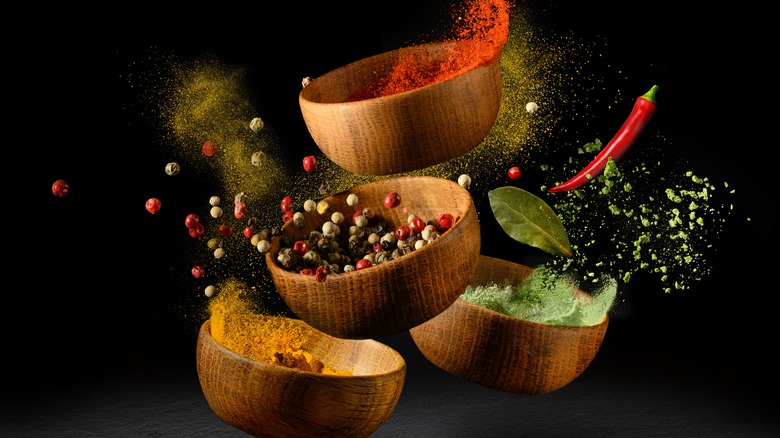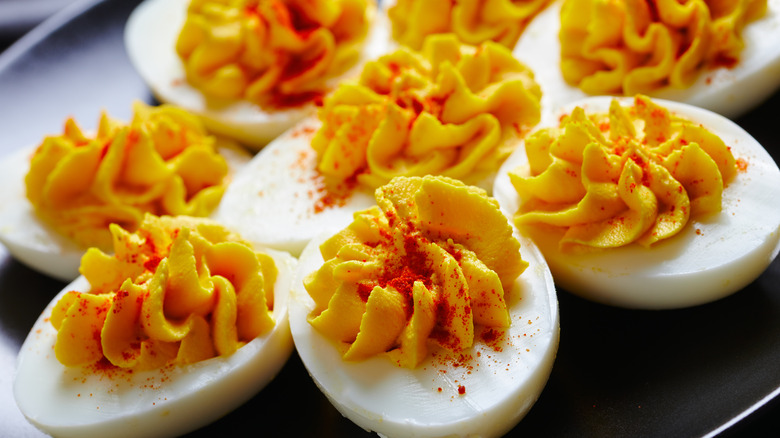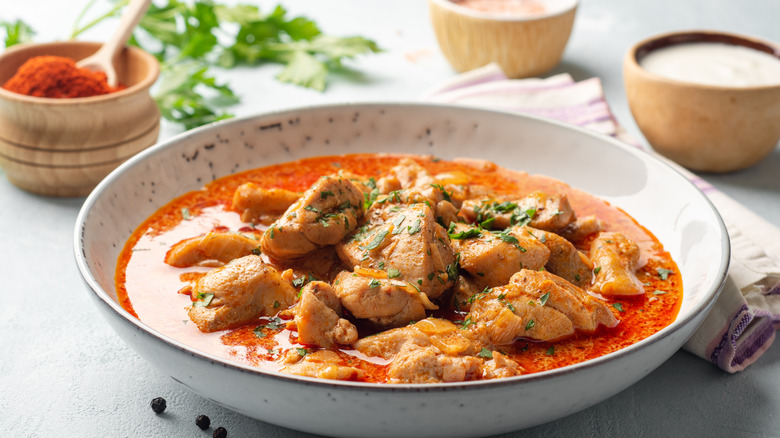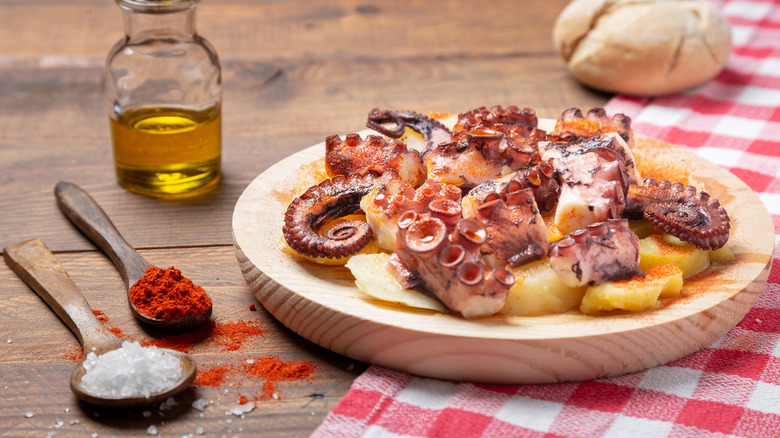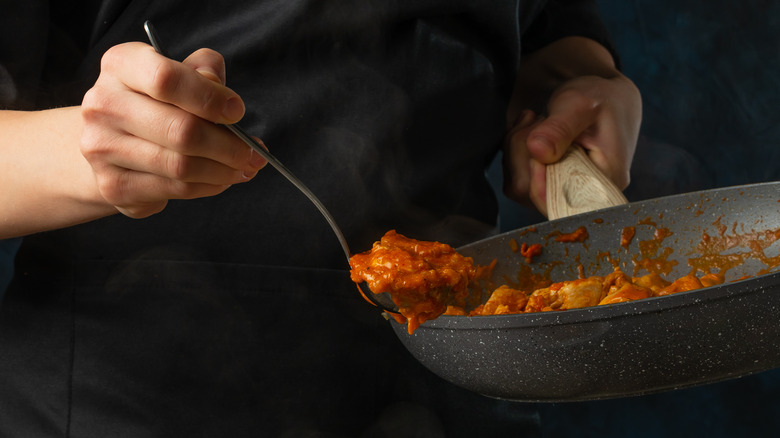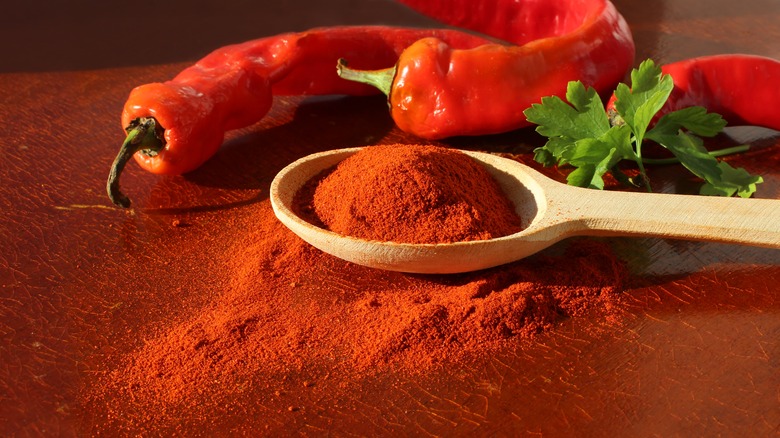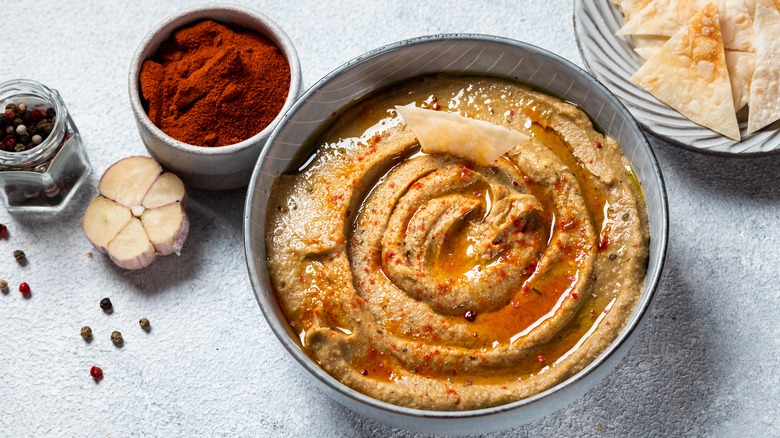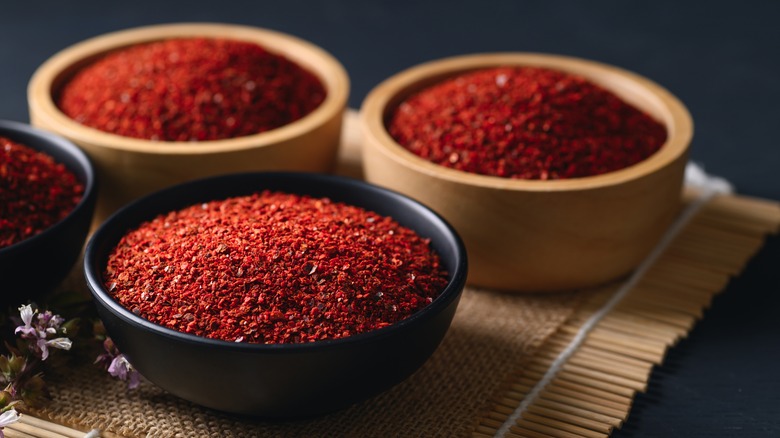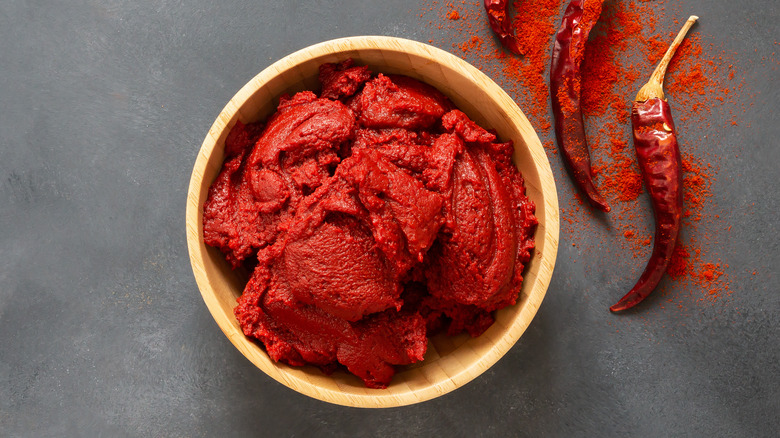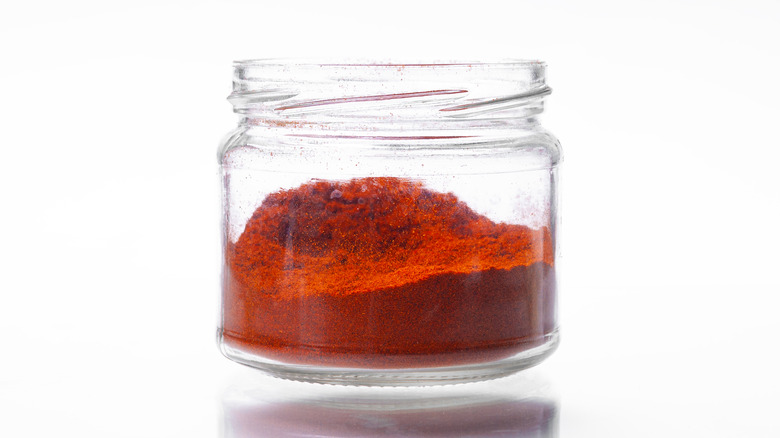12 Tips For Cooking With Paprika
We may receive a commission on purchases made from links.
Paprika, with its fiery red color, is one of the world's most ubiquitous spices. Essential in both Hungarian and Spanish cooking, it's also a crucial element in many spice blends spanning the globe. There's a type of paprika suitable for just about any dish, cuisine, and purpose, whether you're garnishing deviled eggs or enhancing a slow-cooked stew.
It's made from peppers in the Capsicum annuum species, which includes varieties as diverse as the spicy cayenne and the mellow poblano, along with many types of mild, sweet peppers that commonly make the base for paprika, as McCormick Science Institute explains. These peppers made their way from the Americas to Europe in the era of cross-Atlantic exploration, and eventually the peppers — and the products made from them, like paprika — spread across the planet.
Generally not as hot or pungent as other types of ground red pepper like cayenne or chili powder, paprika can be utilized in all sorts of dishes, making it a valuable workhorse in the kitchen. It's no slouch in the health department, either, as it's jam-packed with vitamins A, E, and B6, as well as iron and antioxidants, according to Healthline. If you're not sure how to add more of this spice to your life, here are some helpful tips to get you started.
1. Get to know the many types of paprika
Not all paprika is created equal. Before you throw some of this scarlet powder into a dish, it's helpful to know the different styles. Paprika can be broken down into three basic types: sweet, hot, and smoked. Each has its own unique flavor profile and is best suited for different purposes.
Despite its descriptor, don't think of sweet paprika as sugary-sweet, but as a gentler, more mellow pepper flavor than the others, with a slight fruity tang. Hot paprika, at the other end of the spectrum, has more of a kick to it, so you'll get the same peppery flavor as well as a punch of heat. If you're wondering about the difference between paprika and smoked paprika, peppers are fire-roasted before they're dried and ground to make smoked paprika, a process which gives this version a unique flavor all of its own, adding warm meaty and savory notes.
Within these three basic styles there is a lot of variation, particularly in the two countries famous for their paprika. Hungary has eight different categories of paprika based on subtle differences in color and pungency, as Budapest by Locals explains. In Spain, pimentón, as it's called, comes from two different regions, and will be labeled as such: Pimentón de la Vera for smoked, and Pimentón de Murcia for unsmoked (per Cook's Illustrated). Within those two categories you'll see dulce, agridulce, and picante -– mild, medium, and hot, respectively.
2. Since paprika is relatively mild, you can use it generously
As paprika is a product made from peppers, you might assume it has a spicy heat to it. Some varieties certainly pack some punch, but there is a wide range of styles of paprika that exhibit varying levels of intensity. The pepper usually used to make paprika ranks fairly low on the Scoville scale which measures heat, and generally ranges from 250 to 1,000 Scoville units. To compare, cayenne peppers reach anywhere from 30,000 to 50,000 units, as MasterClass explains. However, paprika is often made from a combination of different peppers, and the blend of varieties is what will determine the spice's ultimate heat level.
Unless you have your hands on a particularly hot paprika, it's most likely going to be significantly milder than its look-alike spice siblings, such as chili powder and cayenne pepper. Therefore, you don't need to be as cautious when adding it to dishes, as it's unlikely to overwhelm other flavors with too much heat.
3. Paprika is a great addition to spice blends
While paprika is often used on its own to season dishes, it plays so well with other spices, herbs, and flavors that you'll frequently find it as an integral ingredient in spice blends. Because of its range and versatility, it's a welcome addition to all kinds of cuisines and flavor profiles. As The Spice House notes, it's often found combined with spices as varied as basil, saffron, and turmeric, and complements ingredients from potatoes to yogurt, and from celery to duck.
The spice blend Baharat, found throughout the Middle East, North Africa, and the Mediterranean, includes paprika along with spices including cumin, coriander, clove, and others, to add depth and warmth to dishes (per Daring Gourmet). American spice blend Old Bay, which is often used with seafood, melds paprika with celery seed, mustard, and other peppery spices to create its iconic flavor. And paprika is an essential element in Montreal steak seasoning, according to CBC/Radio Canada, while many of the other ingredients around it can vary.
The next time you're mixing up spices for a marinade, dry rub, popcorn topping, or stew, make sure to add some paprika to the blend.
4. Paprika is commonly sprinkled on foods as a garnish
Because of its stunning crimson color, paprika makes a great garnish, adding a pop of bright red to complement or contrast a dish. It's recognizable as the scarlet powder that graces the tops of a classic deviled eggs recipe. Part of its appeal as a garnish, besides its appearance, is its relatively mellow character. You can sprinkle paprika in generous portions over your food and not worry that it's going to take over the other flavors, or add too much spice for your palate to handle.
Aside from deviled eggs, paprika can be used to garnish a whole slew of other foods. Other egg dishes, including omelets, fried eggs, quiches, and frittatas, all welcome a sprinkling of the stuff. As it's included in the famous seafood spice blend Old Bay, paprika of course pairs nicely with seafood, too, and can make an excellent garnish for fish and shellfish dishes. Sweet paprika is best to garnish mild and delicate dishes, but if you want to add a bit more punch, you can opt for a dusting of the smoked or hot varieties.
5. Paprika is a fundamental ingredient in Hungarian cuisine
Over the past several centuries, since peppers made their way from the Americas to Europe and beyond, paprika has wound its way into the hearts and dishes of Hungarians. It's become such an important part of Hungarian cuisine that it is now considered the country's national spice. It shows up in almost every traditional Hungarian recipe and is widely used as a garnish: It's as commonly available on the table as salt and pepper. And because it's produced within the country, it's easy to find paprika at its freshest, giving dishes that earthy, sweet, and peppery taste, very different from what you'll find elsewhere in the world, as Rick Steves' Europe describes.
The base of many Hungarian recipes is the combination of onion, paprika, and fat, according to Taste Hungary. This trio of ingredients makes the base of chicken paprikash and goulash, two of Hungary's most iconic traditional dishes. Paprika is the star of the show in other recipes, from hortobágyi palacsinta, meat-stuffed crêpes draped with a rich, creamy sauce loaded with paprika, to körözött, a paprika-spiked cheese dip. If you're a fan of paprika, there may be no better place in the world for you to eat than Hungary. If you can't get yourself to Hungary for a vacation, grab a few recipes and start exploring this fantastic cuisine.
6. Paprika is a major element in many Spanish dishes
Similar to Hungary, Spain gained love for paprika as peppers made their way across the Atlantic. The climate proved conducive to growing the new plants, particularly in the region of Extremadura, and as their cultivation continued, their popularity as a cooking ingredient grew, as Spanish Sabores explains. Now paprika is one of the most used and recognizable spices in Spanish cuisine.
Paprika, or pimentón as it's locally known, is more likely to be found smoked in Spain than in Hungary. Its production is carefully regulated for quality and taste with rules in place specifying which pepper varieties and processes can be used to make the various styles. As Hungary uses onion, paprika, and fat as the base to much of its cuisine, Spanish cuisine uses sofrito — a mix of onion, garlic, peppers, tomatoes, and paprika cooked in olive oil. You'll find this staple as the first step in crafting many iconic Spanish dishes, most famously paella. As paprika nicely complements seafood, you'll find it prominent in many of Spain's coastal cuisines, used with ingredients like shrimp and octopus. And it's an essential component in sausages like chorizo, not just for flavor but to also add that vibrant red color.
7. Cook paprika carefully to avoid burning it
Hot paprika expresses its flavor more intensely when it's exposed to heat, according to epicurious, so if you're looking to get the most out of the spice, you'll want to make sure it's cooked. However, this can lead to ruin, as the fine powder is rather delicate when it comes to heat, and overcooked paprika becomes colorless, flavorless, and bitter.
The best way to prevent burning your paprika is to let it bloom swiftly and gently in heated fat, as Taste Hungary explains, whether it's the traditional Hungarian lard, Spanish olive oil, or another fat of your choosing. Once the fat is hot, you can pull it away from its heat source before adding the paprika. The residual heat will keep the substance warm enough to properly cook the paprika without the danger of it getting too hot and venturing into burn territory. Never try to heat paprika without fat or some other liquid element to act as a buffer between the hot surface and the spice, or you'll end up with a bitter, blackened mess.
8. Paprika can be used to add color and flavor
Paprika's bold red color is what makes it such an eye-popping garnish, and adds another dimension besides flavor to foods that it's used in. In fact, the color of paprika is so intense and desirable that it's often extracted and used as a natural coloring agent in foods and other products like cosmetics and pharmaceuticals, as ScienceDirect explains. The extracted form is called paprika oleoresin. Because it's naturally derived from plants, consumers often prefer it as they'll see "spice extract" on an ingredients list, instead of a synthetic "coloring."
Using mild sweet paprika is a great way to heighten the color of food without adding too much flavor. Try swirling some paprika into soups, stews, salad dressings, dips, or anything else that could use a visual boost. Just make sure to taste as you go to make sure the addition is not overwhelming the rest of your flavors, and of course, don't forget to sprinkle some over the top as a garnish. Paprika is a simple way to liven up a bland-looking dish.
9. Smoked paprika can add meatiness to vegetarian and vegan dishes
For vegetarians and vegans who occasionally salivate at the memory of fried bacon and grilled burgers, smoked paprika can be a godsend. The smoky, savory flavor of the spice brings to mind cured or charred meats, helping to satisfy that carnivorous craving while keeping you firmly in your plant-based lifestyle (via Exceedingly Vegan).
Add it to any vegetarian or vegan version of a recipe that would traditionally call for smoked pork, like bacon or pancetta, and you'll be amazed at how much similar flavor character smoked paprika brings to the table. It makes meatless carbonara possible, and deepens the flavor of collard greens without the traditional use of ham hocks. Add it to your delicious veggie burger mix to get that fire-grilled barbecue flavor. And if you're using tofu or tempeh as a meat substitute in a recipe, a little smoked paprika will add a ton of deep, robust flavor.
10. Be careful when substituting other spices for paprika
Because of their visual similarities, it's tempting to think of all red ground spices as interchangeable. Without labels, it would be nearly impossible to tell the difference between paprika, cayenne pepper, and chili powder. In some cases, it is possible to swap one for another, but it's important to know the details of each spice in order to make sure you're not accidentally shifting the entire flavor profile of your dish.
Heat level is the first factor to consider. If you're looking for a sweet paprika substitute, you'll want to stay away from cayenne pepper, as it's going to pack a much bigger punch as far as spiciness is concerned. It can, however, be used in place of hot paprika, and vice versa, although their fieriness may not exactly match up, so it's best to err on the side of caution when adding the spice to your dish. Smoked paprika is best substituted with another smoky spice, such as chipotle powder.
Chili powder is a bit of a wild card, as it's typically a blend of peppers and other ingredients, such as garlic and onion, and its heat level can vary greatly from brand to brand. Keep in mind if substituting chili powder for paprika that it will add these other flavors as well, so it won't give you the exact pure and earthy pepper flavor that you'll get from paprika.
11. Paprika can also be found in paste and oil forms
Besides using ground spice powder, there are other ways to add the flavor and color of paprika to your cooking. If you're in Hungary or shopping in a specialty store that carries Hungarian products, you'll likely see paprika-based products in every conceivable form. The most common types you'll find are paprika paste and paprika oil, and both can be utilized in different ways.
According to Taste Hungary, Piros Arany and Erős Pista are the top two most popular paprika-based goods in the country — both are pastes made from peppers and salt, and are used to add dimensions of flavor, heat, and seasoning to your food. There are other versions of paprika paste available in varying levels of spice intensity. These pastes typically come either packed in jars or in squeeze tubes, similar to tomato paste.
Paprika oil is another popular product that can bring color and depth of flavor to your food. Just like any other herb or spice-infused oil, it can be drizzled on top of finished dishes as an attractive garnish with a welcome pop of aroma and flavor. Its fiery red drops look great on top of soups or mixed into salad dressings.
12. Ground paprika will lose color and flavor over time
Like all ground spices in your kitchen, paprika won't remain at peak intensity forever. Over time, spices lose their flavor and color, even if stored carefully. They won't go bad like other foods, but they will become less potent and therefore not particularly useful — a flavorless spice is basically just dust, and won't add much of anything to your food.
According to McCormick Science Institute, most spices have a shelf life of anywhere from one to four years. Your spices will remain fresh for the longest amount of time if you keep them airtight, sealed, sheltered from light, and away from heat. This is a great way to store spices that you use intermittently; however, it's not very convenient with those that you use on a regular basis. It's okay to keep your spices out and close at hand if you go through them quickly enough that you're not worried about degradation, and if you keep spices out where you can see them, you might be inspired to experiment with them more often.
Labeling your spices with a date when you first open them is a great way to keep track of when they should be replaced. If you're not sure how long that paprika jar has been sitting there, give it a quick smell and taste test: If it's dull or bland, it's time to toss it and go paprika shopping.
